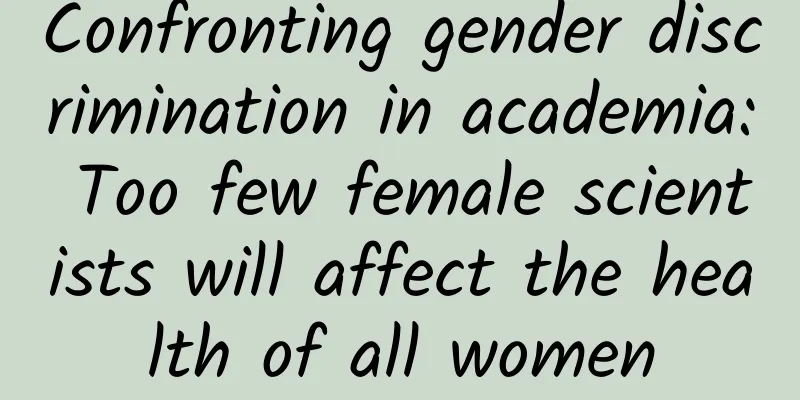Confronting gender discrimination in academia: Too few female scientists will affect the health of all women

|
Eternal feminine, lead us upward. Das ewige weibliche zieht uns hinan. ——Goethe von Goethe Written by | Guo Ruidong On July 19 this year, the Ministry of Science and Technology, the All-China Women's Federation, the Ministry of Education and 13 other departments jointly issued the "Several Measures on Supporting Female Scientific and Technological Talents to Play a Greater Role in Scientific and Technological Innovation", supporting female scientific and technological talents: women are given priority under the same conditions. Currently, women account for more than half of those with a master's degree or above, but the proportion of women among doctoral students is still insufficient. The proportion of women among academicians of the Chinese Academy of Sciences and the Chinese Academy of Engineering is 6% and 5.3% respectively. Among the experts and scholars selected for the national talent plan, women also account for only about 10%. Figure 1. Education statistics from the Ministry of Education website from 2005 to 2019 In the academic circle, gender inequality still exists due to various historical reasons. In 2020, the Proceedings of the National Academy of Sciences (PNAS) counted scholars who have been active in publishing papers in many countries and disciplines since 1955, and found that although the proportion of female researchers has increased, it only accounts for 27%, and there are serious disciplinary differences. Figure 2. The proportion of male and female researchers active in the scientific community in various disciplines and countries since 1955. (Females in red, males in blue) [5] Today’s article will combine a number of relevant studies to point out the problem of gender inequality in the academic field and its impact, and then try to analyze the source of the problem and discuss corresponding intervention measures. Women: Invisible in research On July 2, 2021, the Journal of the American Medical Association (JAMA) published a paper[1] that analyzed 5,554 medical papers published in top medical journals between 2015 and 2018. The paper found that 35.6% of the papers had a female first author and 25.8% of the papers had a female corresponding author. The median number of citations of papers with female first authors by other academic articles was 36, while the median number of citations of papers with male first authors was 54, much higher than the former. The median number of citations of papers with female co-authors was 37, while the median number of citations of papers with male co-authors was as high as 51, also much higher than the former. This situation is not only seen in the field of medicine, but also in the field of chemistry. According to a 2019 report in Nature magazine[2], the citation rate of papers with female authors in the field of chemistry is 25% lower than that of papers with male authors (an average of 5.6 times compared to an average of 7.2 times). Female researchers are not only ignored in terms of paper citations, but also face unequal treatment in terms of income. According to a study in New Zealand last year[7], among researchers with equal academic achievements and output, female researchers have a lifetime income of $132,000 less than male researchers. According to a report from the National Science Foundation (NSF)[8], for those who received a doctorate in 2016 and have long-term employment in mathematics, physics, life sciences, social sciences, psychology, computer science or engineering, the median annual salary for women is $74,000, while for men it is $92,000, 24% higher than for women. One of the biggest obstacles for women to engage in academic research is raising children. A press release published on July 20 this year by Nature magazine[9] surveyed more than 9,000 female researchers in 128 countries and found that 34% of women would leave full-time STEM (science, technology, engineering and mathematics) research positions after the birth of their first child. For women who stayed, the impact of raising children accumulates year by year: nine years after the birth of their first child, these mothers had published an average of 10 fewer papers than fathers. Figure 3. Cumulative number of papers published by women and men before and after the birth of their first child in the fields of computer science (blue), business (red), and history (green). The size of the gender difference varies across disciplines, and we can see that in the STEM field of computer science, the number of papers published by women after giving birth drops significantly. [10] This survey is consistent with the conclusion of a paper published in Science Advances in 2021[3], which also pointed out that raising children has a greater impact on female researchers. Considering that taking care of the family will affect the career development of female scholars, the difference in paper citations and income will obviously further widen the gap between them and male scholars. Figure 4. Career length, average annual output, total output, and total impact of male and female researchers since 1955 (female in red, male in blue). It can be seen that for the top 20%, there is a huge difference between female and male researchers, and this difference comes from the difference in the total length of their careers. [5] The impact of female researchers being ignored As we all know, the size of piano keys is customized for men, which obviously increases the difficulty for women to play the piano. It can be seen that industrial standards will undoubtedly greatly affect the development of the music industry. Similarly, gender inequality in academia has far-reaching real-world consequences. An article published in Science magazine in June this year [3] showed that among all biomedical patents in the United States between 1976 and 2010, there were significantly fewer patents invented by female-led teams (meaning that women accounted for ≥50% of the team). Figure 5. Number of patents invented by male-dominated teams (>50% male) and female-dominated teams between 1976 and 2010. [3] The researchers used natural language processing to classify these patents and found that inventions from female-led teams were more likely to focus on women's health and medical needs. This tendency was strongest in all-female invention teams - they were 8.7% more likely to focus on women's health than the average, and 35% more likely than all-male teams. Of the 373,774 patents invented by male-led teams, 13.3% were for men's health issues, 12.4% were for women's health needs, and the rest were not gender-specific; among patents invented by female-led teams, the proportions were 12.5% and 14.7%, respectively. The study also found that female-led teams were 2.4% more likely to produce inventions in nonprofit organizations than in for-profit companies, possibly due to the relatively low representation of women in corporate management. Figure 6. The proportion of patents and scientific research papers in the biomedical field that focus on women’s health issues. The higher the proportion of female members in the team, the greater the probability that the team will focus on women’s health issues. [3] Women’s health issues have also been neglected for a long time in the drug development process. Since most of the volunteers used in clinical trials are men (because there is no strict gender requirement), women may be more likely to be troubled by drug side effects. These data mean that the lack of female researchers will be detrimental to women's health. Women have unique life experiences that are different from men, so women's participation is necessary to promote basic research and medical inventions suitable for women. We encourage more women to become inventors or researchers; research teams dominated by male members also need to realize that they may not pay enough attention to women's health demands - both sides work together to make up for the historical debt. In addition, the lack of female researchers will also affect the next generation's impression of STEM subjects. In particular, once subjects such as mathematics, physics, and computer science are labeled as male, they will promote "self-fulfilling prophecies" and cause continued gender inequality. According to a 2019 Swedish study[10], middle school students will classify mathematics, physics, and chemistry as male-exclusive subjects, which will ultimately affect girls' desire to enter university to study STEM majors. Similarly, a 2020 IEEE study on computer science[11] also discussed this issue and pointed out possible improvement measures, such as revising textbooks and recruiting more female students in these majors. Why are women ignored? A study published in Nature Neuroscience in June 2020[4] found that in the field of neuroscience, papers with both male first and co-authors accounted for a disproportionate number of citations, and that male authors tended to cite papers by male authors the most, a phenomenon known as “male attraction.” Worse still, this phenomenon will become more and more serious over time. Figure 7. Papers with both first and co-authors being men (MM) also tend to cite papers with both first and co-authors being men (MM) the most (top left). Papers with at least one first author or co-author being a woman (W∪W) have a relatively small citation difference (top right). (Citing: Cited authors; WM: first author is a woman, co-author is a man; MW: first author is a man, co-author is a woman; WW: first author and co-author are both women) [4] The researchers investigated 54,000 papers in the field of neuroscience between 2009 and 2018 and found that when either the first author or the co-author was a woman, the number of citations for the paper would be lower than expected. When both the first author and the co-author were women, the proportion of citations for the article decreased by 23.4%. It is noteworthy that in the 1950s, female authors actually received slightly more citations than male authors[5], but by the 2000s, this gap had reversed to 34%, and the gender gap in citations is increasing by 0.4 percentage points per year. This suggests that despite the growth in the number of women in neuroscience, the citation data do not reflect this change, and papers by male researchers are still more favored. Why is there a gender gap in the number of citations of academic papers? Who is responsible for this phenomenon? This is bound to be a controversial answer. Generally speaking, male researchers have more male friends, and researchers will cite the research of people they are familiar with, so men will cite more results published by men. Isn't this normal? However, this study ruled out the explanation of "social network structure". Based on the record that two authors have co-published papers in the past, researchers can construct a co-author network and find that the impact of social networks is not that great. Male authors still tend to cite papers by other male authors, and this trend is getting bigger. Figure 8. After removing the influence of social networks (Figures B and D), the proportion of “male-male citations” is still the highest and has a growing trend. [4] Of course, this study is limited by data and only observes the social impact of paper collaboration, without considering the impact of social relationships formed in more informal occasions, which makes the above conclusion less rigorous. In addition, even if this conclusion is true, it does not mean that male researchers consciously discriminate against their female counterparts. On the contrary, the relevant research methods of social networks can be used to trace the source of gender inequality in the academic circle and improve the system. In August this year, the website of the National Bureau of Economic Research (NBER) published a study[13] that used natural language processing technology to automatically classify papers in the biomedical field from 1980 to 2008, and found that new ideas and technologies proposed by women were relatively ignored. By analyzing the paper collaboration network, the researchers found that female researchers were in a relatively marginal position, and most female innovators had fewer close connections in the network. Moreover, even in a relatively small social network, men were less likely to accept new ideas proposed by women. The studies mentioned above are all based on historical data, but a Nature paper published earlier this year [12] proposed an online real-time assessment tool that can quantify gender discrimination in the job search process. The researchers found that female job seekers in male-dominated industries had 7% fewer chances of getting their resumes accepted, and that men also faced discrimination in female-dominated industries. Although this tool is not targeted at the academic community, such online tools can help us get feedback more quickly and better judge whether interventions against gender discrimination are working as intended. What should we do? Facing gender inequality in academia means that we need to see that women in academia, even in the fields of medicine and biology where women are relatively more involved, still suffer significant unequal treatment. And this inequality is harming the rights and interests of all women and all mankind. Goethe said: "The eternally female draws us onward." How many potential Marie Curies are being missed by us, and how many women are experiencing the experience of Rosalind Elsie Franklin, the "mother of DNA", whose research results and contributions lack recognition from the academic community. In the "Several Measures on Supporting Female Scientific and Technological Talents to Play a Greater Role in Scientific and Technological Innovation" (click the "Original Link" at the end of the article to check), the state proposed 16 specific measures, among which the three most noteworthy ones are: First, encourage scientific research institutions to set up funds for the return of female scientific researchers to scientific research positions after giving birth, extend the evaluation and assessment period, and implement a flexible working system; Second, carry out gender equality education, encourage female students to participate in science and technology competitions, set up scholarships for outstanding female college students in science and engineering, and guide more female students to choose scientific research as a lifelong career; Third, support female scientific and technological talents in obtaining scientific and technological resources, undertaking scientific and technological planning projects, better play the role of female scientific and technological talents in scientific and technological decision-making consultation, and support female scientific and technological talents to be selected for national high-level talent programs. These three points correspond to the three problems pointed out in this article: ① Women lack the motivation to enter the scientific research industry, ② Scientific careers are shortened due to childbirth, and ③ There is a lack of high-level leading talents. The original intention of the author to write this article is also to let more people understand and face the gender equality issue in the academic world, discuss and find simple and effective intervention plans together, so that the whole society can benefit from more female-led research. References [1] Chatterjee P, Werner RM. Gender Disparity in Citations in High-Impact Journal Articles. JAMA Netw Open. 2021;4(7):e2114509. doi:10.1001/jamanetworkopen.2021.14509 [2] https://www.nature.com/articles/d41586-019-03438-y [3] https://science.sciencemag.org/content/372/6548/1345 [4] Dworkin, JD et al. The extent and drivers of gender imbalance in neuroscience reference lists. Nat. Neurosci. https://doi.org/10.1038/s41593-020-0658-y (2020) [5] Huang, J. et al. Historical comparison of gender inequality in scientific careers across countries and disciplines. Proc. Natl. Acad. Sci. USA 117, 4609–4616 (2020) [6] Balafoutas, L., Fornwagner, H. & Sutter, M. Closing the gender gap in competitiveness through priming. Nat Commun 9, 4359 (2018). https://doi.org/10.1038/s41467-018-06896-6 [7] https://journals.plos.org/plosone/article?id=10.1371/journal.pone.0226392 [8] https://www.nature.com/articles/d41586-018-00113-6 [9] https://www.nature.com/articles/d41586-021-01993-x [10] https://www.frontiersin.org/articles/10.3389/feduc.2019.00060/full [11] https://ieeexplore.ieee.org/document/9273933 [12] https://www.nature.com/articles/s41586-020-03136-0 [13] https://www.nber.org/papers/w29179 |
<<: Insomnia, hair loss, and possible extinction... It's really hard to be a giraffe!
Recommend
The "diamond" back cover plus the super AMOLED screen make the front and back of the Xiaomi Chili Pepper 7 outstanding.
When consumers buy a mobile phone, they will have...
11 open source projects for machine learning
Machine learning is a hot topic in the field of d...
Don’t say “freezing like a dog” when the temperature drops. This is a bit unfair to dogs…
As the weather in the northern hemisphere gets co...
Electric Technology News: Known as the most unknown SUV in China, can the new Bisu T5 surpass the Haval H6 by a large margin?
With the relaxation of the two-child policy and t...
How did Yuan blue and white porcelain, the ancestor of blue and white porcelain, appear and become popular in the world?
The Yuan blue and white double-handled small jar ...
Can you get rockets by reading articles? Experience two major new features of WeChat
Friends who are familiar with WeChat know that, a...
Using objects to represent people and expressing one's aspirations: a unique category of "poetry about objects" in ancient Chinese poetry
China is a country of poetry. Among the numerous ...
Essential for contacting Apple! The most complete official contact information of App Store! Updated July 2017
The main contact methods currently published by A...
The three laws of traffic products
Why can Waipojia’s Mapo Tofu be sold for as low a...
JD’s advertising copy is heartbreaking!
JD.com shot a new advertisement Offended all the ...
Handsome, cute and cool, there are many ways to keep spacecraft warm
How can spacecraft maintain stable heat preservat...
SaaS Enterprise Promotion and Customer Acquisition Guide: Finding the Best Channel
Buffett said: If you have 40 wives and concubines...
Nature: The more you exercise, the smarter you are! Mice lying flat grow more brain cells
Coffee in the left hand and "happy water&quo...
Memory price hikes bring huge profits, but Samsung's position is not secure
Electronic product enthusiasts have been a bit de...
It doesn’t matter if you don’t have enough budget. We will teach you how to promote for free on a platform with 700 million users.
We all know that how many people can be promoted ...









